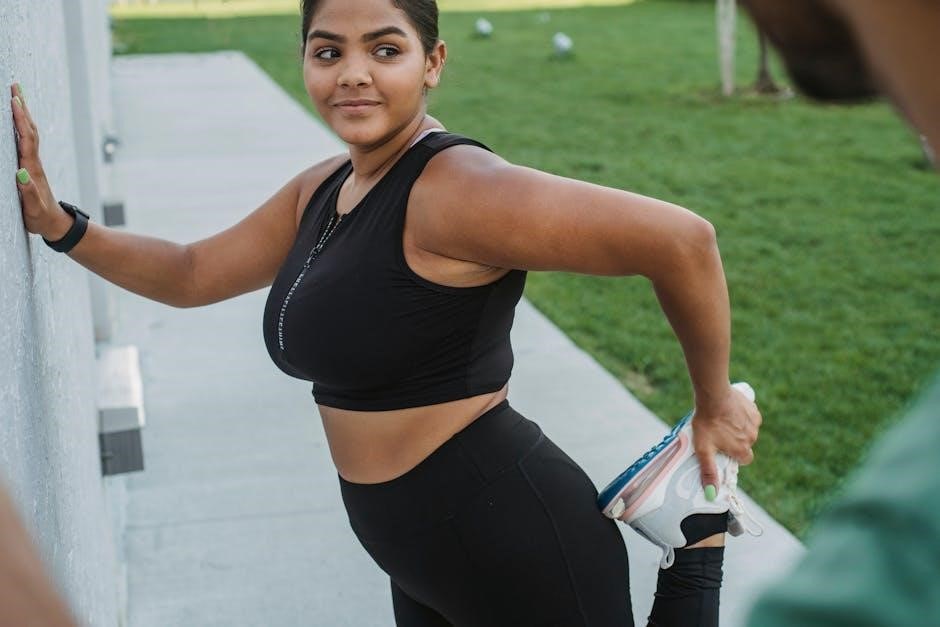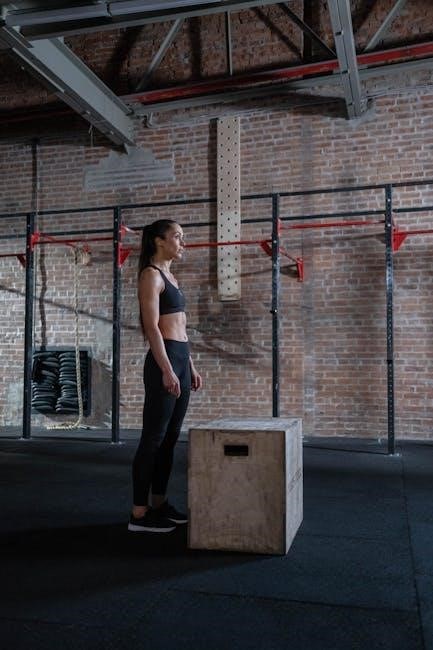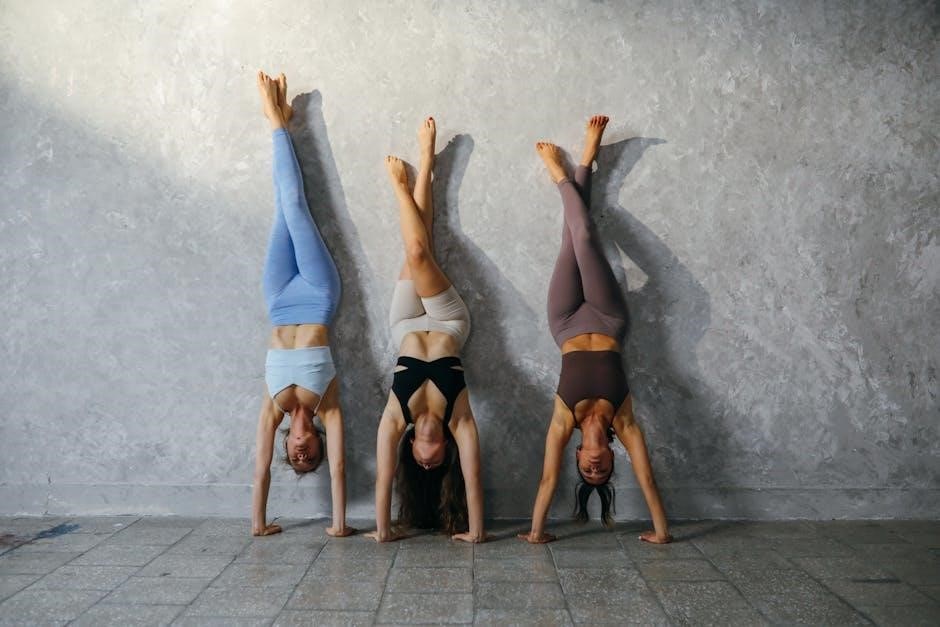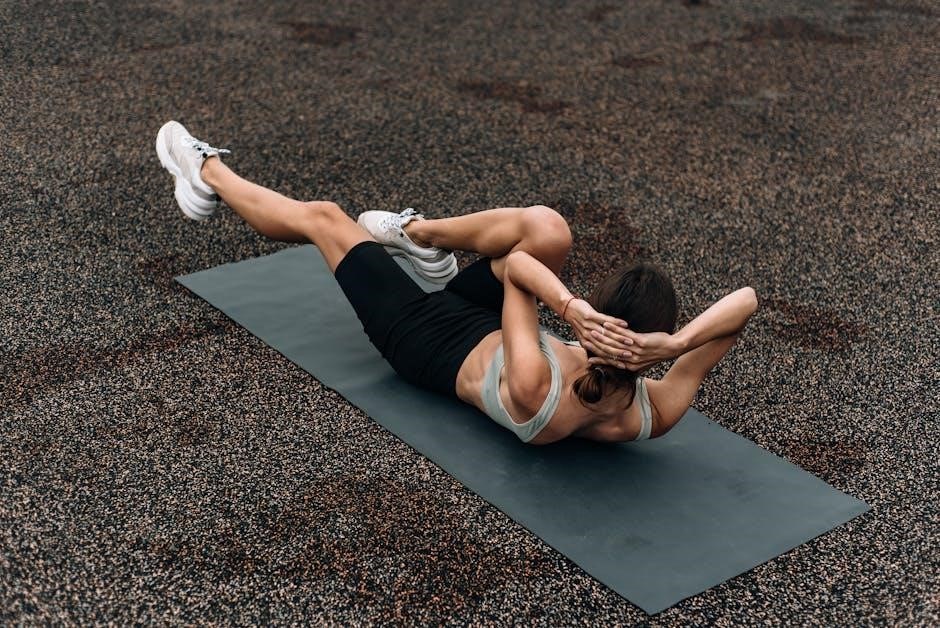Calisthenics training is a versatile‚ low-cost workout method using bodyweight to build strength‚ mobility‚ and flexibility. Ideal for all fitness levels‚ it requires minimal equipment and offers comprehensive guides‚ including downloadable PDF plans for structured routines.
What is Calisthenics?
Calisthenics is a form of exercise that relies on bodyweight to build strength‚ improve mobility‚ and enhance flexibility. Originating from the Greek words “kalos” (beauty) and “sthenos” (strength)‚ it requires minimal equipment‚ making it accessible to all fitness levels. This versatile training method uses gravity as resistance‚ allowing individuals to perform exercises like push-ups‚ squats‚ and lunges; Calisthenics is ideal for those seeking a cost-effective‚ equipment-free way to improve physical fitness. Its adaptability ensures that workouts can be tailored to suit beginners or advanced trainees‚ with downloadable PDF guides providing structured routines for progressive training.
History and Evolution of Calisthenics
Calisthenics‚ derived from the Greek words “kalos” (beauty) and “sthenos” (strength)‚ has ancient roots in Greece‚ where it was used for physical conditioning. Over centuries‚ it evolved into a structured form of exercise‚ gaining popularity in the late 19th and early 20th centuries in schools and military training. Initially focused on basic movements like squats and push-ups‚ calisthenics became a cornerstone of physical education. In the 21st century‚ it experienced a resurgence‚ blending traditional techniques with modern bodyweight training. Today‚ it is celebrated for its accessibility‚ requiring no equipment and offering adaptable routines for all fitness levels‚ as detailed in various PDF guides.
Benefits of Calisthenics
Calisthenics enhances strength‚ mobility‚ and flexibility while improving balance and overall fitness. It requires no equipment‚ making it accessible and effective for all fitness levels.
Improved Strength and Mobility
Calisthenics training significantly enhances strength and mobility by utilizing bodyweight exercises. These workouts target multiple muscle groups‚ improving overall muscle development without the need for heavy equipment. By focusing on movements like push-ups‚ squats‚ and lunges‚ individuals can build functional strength that translates to daily activities. Progressive overload through increased reps or advanced variations helps maintain continuous progress. Additionally‚ calisthenics improves joint mobility‚ making it easier to perform a wide range of motions. The combination of strength and mobility training creates a balanced physique‚ preparing the body for more challenging exercises and enhancing overall physical performance. Regular practice ensures consistent gains in both areas.
Enhanced Flexibility and Balance
Calisthenics training is exceptional for improving flexibility and balance. Bodyweight exercises like lunges‚ squats‚ and planks require precise movements‚ enhancing coordination and stability. Dynamic stretches and flowing routines increase range of motion‚ making daily activities easier. Balance-focused exercises‚ such as single-leg stands or pistol squats‚ strengthen core stability and overall equilibrium. Regular practice improves posture and reduces injury risk. The low-equipment nature of calisthenics allows for consistent flexibility and balance training anywhere. Over time‚ these improvements translate to better physical performance and confidence in various activities. Consistency in calisthenics ensures long-term gains in flexibility and balance‚ creating a stronger‚ more agile body.

Calisthenics Workout Plans
Calisthenics workout plans offer structured routines for all fitness levels‚ from beginner to advanced‚ providing clear guidance and progression strategies to achieve strength and mobility goals.
12-Week Calisthenics Workout Plan
The 12-week calisthenics workout plan is a comprehensive program designed to enhance strength‚ mobility‚ and overall fitness. This structured plan is divided into phases‚ gradually increasing in intensity. It includes bodyweight exercises like push-ups‚ squats‚ and lunges‚ along with progressive overload techniques. The plan caters to all fitness levels‚ allowing modifications to suit individual capabilities. Each week focuses on specific muscle groups‚ ensuring balanced development. The program also incorporates warm-up routines and recovery strategies to maximize results and prevent injury. Downloadable PDF guides provide easy access to daily workouts‚ making it convenient to track progress and stay motivated throughout the 12-week journey.
6-Week Calisthenics Workout Plan for Beginners
The 6-week calisthenics workout plan for beginners is an excellent starting point for those new to bodyweight training. Designed to build foundational strength and confidence‚ this program focuses on basic exercises like push-ups‚ squats‚ and planks. It requires minimal equipment‚ making it accessible to anyone. The plan is structured to progress gradually‚ with workouts scheduled three times per week. Each session includes a warm-up‚ core exercises‚ and a cool-down. Modifications are provided to suit different fitness levels‚ ensuring everyone can participate. The program also offers tips on nutrition and recovery to support muscle growth and overall wellness. Downloadable PDF guides make it easy to follow and track progress throughout the 6-week journey.
8-Week Calisthenics Workout Program
The 8-week calisthenics workout program is a structured plan designed to enhance strength‚ balance‚ and flexibility through bodyweight exercises. It is suitable for intermediate trainees who have mastered foundational movements. Each week focuses on specific skills‚ with workouts conducted three times weekly. Sessions are organized into circuits lasting 30-45 minutes‚ combining upper body‚ lower body‚ and core exercises. The program emphasizes progressive overload‚ gradually increasing intensity through advanced variations. A downloadable PDF guide provides detailed routines‚ warm-up protocols‚ and nutritional advice. This comprehensive approach ensures steady progress and helps build a strong‚ balanced physique by the end of the 8-week period.

Calisthenics Exercises
Calisthenics exercises are bodyweight movements that improve strength‚ mobility‚ and flexibility. They include push-ups‚ squats‚ lunges‚ planks‚ and more‚ offering a versatile workout requiring minimal equipment. Detailed guides are available in PDFs.
Foundational Calisthenics Exercises
Foundational calisthenics exercises form the core of any effective workout plan. These include push-ups‚ squats‚ lunges‚ planks‚ and bodyweight dips. Push-ups target the chest‚ shoulders‚ and triceps‚ while squats and lunges build leg strength and mobility. Planks enhance core stability‚ essential for overall body strength. These exercises are fundamental because they require no equipment‚ making them accessible to everyone. They also improve balance‚ flexibility‚ and coordination. By mastering these basics‚ individuals can progress to more advanced movements. Printable PDF guides often outline these exercises‚ providing structured routines for consistent improvement. They are the building blocks for a strong‚ functional physique.
Advanced Calisthenics Exercises
Advanced calisthenics exercises challenge experienced individuals‚ focusing on complex movements that demand strength‚ control‚ and precision. These include one-arm push-ups‚ muscle-ups‚ front levers‚ and single-leg squats. One-arm push-ups build unilateral chest and shoulder strength‚ while muscle-ups combine pull-ups and dips for full-body engagement. Front levers test core strength and stability‚ and single-leg squats enhance balance and leg power. These exercises often require mastery of foundational movements and progressive overload. Printable PDF guides offer structured routines‚ helping users advance safely and effectively. They are designed to push limits‚ promoting elite-level fitness and functional strength. Advanced exercises are key to achieving impressive calisthenics skills and a powerful physique.

Progression and Scaling
Calisthenics progression involves advancing exercises through increased difficulty‚ reps‚ or complexity. Scaling adjusts movements to suit fitness levels‚ ensuring continuous growth and mastery of skills effectively.
How to Progress in Calisthenics Training
Progressing in calisthenics involves gradually increasing exercise difficulty‚ reps‚ or complexity. Start with foundational movements‚ then modify or advance them as strength improves. For example‚ move from knee push-ups to standard push-ups‚ or add variations like diamond push-ups. Incorporate isometric holds‚ such as planks or wall sits‚ to build endurance. As skill levels rise‚ introduce dynamic movements like squats to box jumps or plyometric exercises. Each progression should challenge the body while maintaining proper form to prevent injury and optimize results. Regularly assess fitness levels and adjust routines to ensure continuous improvement and avoid plateaus.
Modifying Exercises for Different Fitness Levels
Modifying exercises in calisthenics allows individuals of all fitness levels to participate effectively. For beginners‚ simplify movements by reducing range of motion or incorporating assistive techniques‚ such as using a bench for push-ups or bending knees during squats. Intermediate trainees can increase reps‚ add complexity‚ or introduce isometric holds to build strength and endurance. Advanced individuals can progress to single-limb exercises‚ plyometric variations‚ or weighted calisthenics. Each modification ensures exercises remain challenging yet achievable‚ promoting safe and consistent progress. Tailoring workouts to individual capabilities maximizes efficiency and keeps training engaging and effective for all fitness levels‚ preventing boredom and enhancing overall results.

Nutrition and Recovery
A balanced diet is crucial for calisthenics‚ focusing on protein for muscle repair‚ complex carbs for energy‚ and healthy fats. Adequate hydration and rest support recovery‚ avoiding processed foods and sugars to optimize performance and muscle growth.
Importance of Diet in Calisthenics
A well-structured diet is essential for calisthenics training‚ as it directly impacts energy levels‚ recovery‚ and muscle growth. Emphasizing protein-rich foods aids in muscle repair and strength development‚ while complex carbohydrates provide sustained energy for workouts. Healthy fats support overall bodily functions and hormone production. Staying hydrated is crucial to maintain performance and prevent fatigue. Avoiding processed foods and excessive sugar ensures optimal recovery and reduces inflammation. A balanced diet tailored to individual caloric needs helps athletes achieve their goals‚ whether focusing on strength‚ endurance‚ or muscle hypertrophy. Proper nutrition enhances the effectiveness of calisthenics routines and supports long-term progress.

Recovery Techniques for Calisthenics Training
Recovery is crucial for optimal progress in calisthenics training. Techniques like stretching and foam rolling help reduce muscle tension and improve flexibility. Incorporating rest days allows muscles to repair and rebuild‚ preventing overtraining. Active recovery‚ such as light cardio or yoga‚ promotes blood flow without excessive strain. Hydration and proper nutrition are essential for muscle repair and energy replenishment. Additionally‚ quality sleep plays a vital role in recovery‚ as it supports muscle growth and overall physical restoration. Ensuring adequate recovery time enhances performance‚ prevents injuries‚ and sustains long-term progress in calisthenics workouts. Balancing training with recovery is key to achieving fitness goals effectively.

Accessories for Calisthenics
Calisthenics primarily uses bodyweight‚ but accessories like resistance bands‚ pull-up bars‚ and gloves can enhance workouts. These tools add variety and intensity while maintaining the essence of bodyweight training.
Useful Equipment for Calisthenics Workouts
While calisthenics relies on bodyweight‚ certain equipment can enhance workouts. Resistance bands add tension‚ pull-up bars aid in upper-body exercises‚ and grip enhancers improve control. Mats provide comfort during floor exercises. Portable equipment like parallettes and boxes can increase exercise variety. These tools help modify movements for different fitness levels‚ ensuring progression and safety. They are often highlighted in downloadable PDF guides‚ offering structured routines for home or outdoor training. Such accessories support a well-rounded calisthenics program‚ making workouts more effective and engaging without compromising the core principles of bodyweight training.


